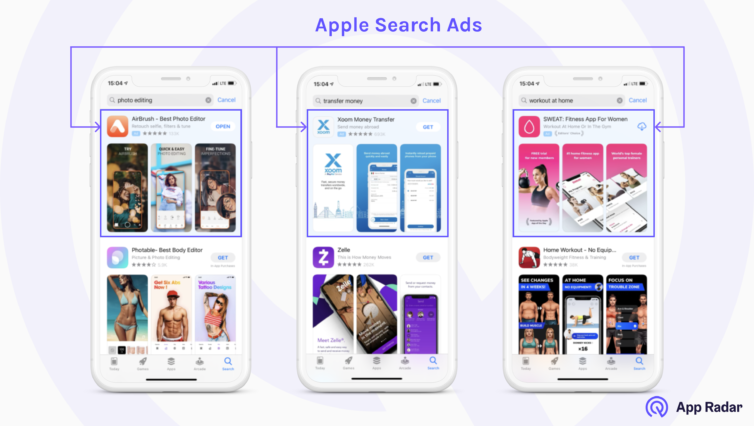
The Apple App Store may be smaller in size than its Google Play Store counterpart, but it generated more than double its revenue in 2023. Over 650 million users visit the App Store weekly, giving you a global platform to grow your business.
There are over 2 million apps available through the Apple App Store. Your business needs the right advertising strategy to stand out from the crowd and enhance your sales funnel. Apple Search Ads are crucial as 70% of people use the search function to find new apps. Leveraging Apple Search Ads will boost your revenue, widen your customer base, and take your business to the next level.
Sign up to AdsPlanner.ai to create engaging, high-performing Apple Search ads with the help of this in-depth guide on the best practices for Apple App Store ads.
Apple launched Search Ads in 2016 to give app developers and marketers the facilities to promote their apps directly through the Apple App Store. During its initial launch, Apple Search Ads worked similarly to order pay-per-click advertising models, such as Google Display Ads.
However, Apple Search Ads have evolved in recent years to adopt a pay-per-tap (PPT) model. These flexible campaign options allow you to increase exposure for your app to boost downloads.
Companies with apps on the Apple App Store need to utilise Apple Search Ads as they are the only way to advertise directly on the App Store. When you use Apple Search Ads, your ad will appear above the first organic search result.
Size and specification requirements for app previews:
Videos for an app preview can be uploaded in tH.264 or ProRes 422 (HQ only).
Apple Search Ads are divided into two categories: basic and advantage. While most marketers will select the basic option, using the advantage option gives you more control and transparency over your ad performance.
Apple Search Ads Basic is designed for start-ups and marketers who want to let Apple make their campaign decisions. It’s an ideal option if you’re managing multiple advertising platforms and want to streamline your advertising.
When you’re setting up an Apple Search Ads Basic campaign, you can set your campaign goal, including countries and regions, and your budget. You can choose the maximum amount you want to spend per install. If you have a smaller budget, limit your campaign goals to one country.
Apple Search Ads operates with a CPI model, meaning you’ll only be charged for the installs you receive from your ads. Set your maximum CPI to stay within your advertising budget.
While basic campaigns put Apple in control, Apple Search Ads Advanced gives you full control over your advertising campaign. Along with your target audience, you’ll also set your target keywords.
Apple Search Ads Advance allows you to set:
Apple uses a cost-per-tap (CPT) model for its Apple Search Ads Advanced. Set your campaign structure using the best practice advice below to ensure users who tap on your ad follow through and download it.
While sizing and specifications matter for Apple Search Ads, what makes the difference is selecting the right keywords and tailoring your advertising campaign. We’re sharing four best practices to implement in every Apple Search Ad campaign to maximise your conversions and grow brand awareness.
The secret to creating successful Apple Search Ads is implementing the correct keywords into your campaign. Your keywords should align with your app’s unique selling point (USP) and its key features. You want to select broad keywords to reach a wider audience. By comparison, using exact keywords will help you target a smaller audience and demographic if your content is niche.
Your target keywords should resonate with your app’s demographic to maximise brand awareness and visibility on the Apple App Store. Don’t forget to consider negative keywords (more on this later) to refine your campaign targeting.
Before you start advertising on the Apple App Store, take the time to do in-depth keyword research. Consider trending terms and keywords that relate directly to the USP and features of your app. You’ll want to regularly monitor the performance of your keywords to optimise your Apple Search Ads.
Your keyword research should also include negative keywords to refine your targeting. This is crucial to maximise your advertising performance as it’ll allow you to remove your ad from irrelevant search terms. It will optimise the effectiveness of your ad to ensure it reaches the right audience.
Regularly assess your data to identify any irrelevant keywords your ad is showing up for. This refining will help maximize your ROI and advertising budget. Negative keywords will improve your audience segmentation to boost engagement.
Don’t make the mistake of setting your maximum cost-per-tap (CPT) bid and calling it a day. You can optimise your Apple Search Ad performance by regularly adjusting your CPT bid by assessing its competitiveness to maximise your conversions in line with your budget. Bid optimization is crucial to achieving a higher ROI and driving downloads for your app.
Best practice for Apple Search Ads includes continuously optimising your ads. Regularly assess your key performance metrics and look for potential areas of improvement. What irrelevant keywords are your ads showing up for? Can you change your call-to-action? Is your ad resonating with your target demographic?
User behaviour and trends change in the blink of an eye. These best practices will help optimize your Apple Search Ads to get your app moving through the best-seller charts.
Create digital ads that convert across all the major advertising platforms, including Apple Search Ads, by signing up to AdsPlanner.ai to streamline your marketing campaigns and maximise your ROI.
We don't just stop at creating exceptional on-brand ad creatives; we take it a step further by managing all of your ad accounts. From strategy to execution, we handle every aspect to ensure you maximize your return on ad spend (ROAS).